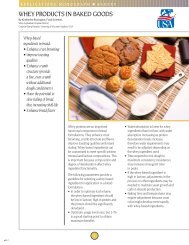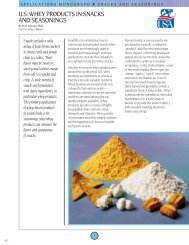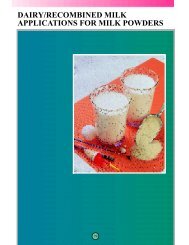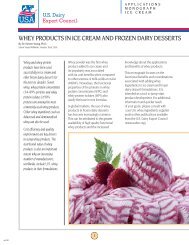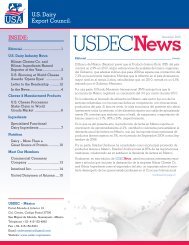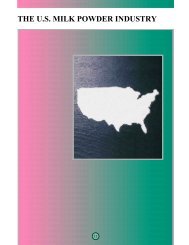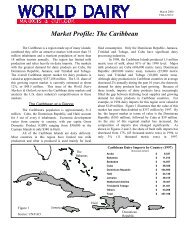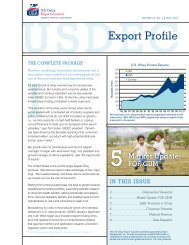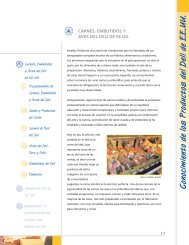Introduction - US Dairy Export Council
Introduction - US Dairy Export Council
Introduction - US Dairy Export Council
You also want an ePaper? Increase the reach of your titles
YUMPU automatically turns print PDFs into web optimized ePapers that Google loves.
U.S. <strong>Dairy</strong> Ingredients in Food Assistance Programs Nutritional, functional benefits and major applications<br />
The U.S. <strong>Dairy</strong> <strong>Export</strong> <strong>Council</strong><br />
The U.S. <strong>Dairy</strong> <strong>Export</strong> <strong>Council</strong> is an independent, non-profit,<br />
membership organization that represents the interests of U.S.<br />
milk producers, dairy farmer cooperatives, dairy processors,<br />
export companies, and suppliers to the dairy industry. <strong>US</strong>DEC’s<br />
more than 65 members represent over 80% of national milk<br />
production and include companies with the widest varieties of<br />
dairy products available anywhere in the world.<br />
This brochure is provided by <strong>US</strong>DEC to help you understand<br />
the nutritional and functional benefits of U.S. dairy ingredients,<br />
and how they can work in food assistance programs: development,<br />
emergency and monetization programs.<br />
<strong>Introduction</strong><br />
The information on infant nutrition and<br />
the formulations presented in this, and<br />
other, <strong>US</strong>DEC publications are provided for<br />
demonstration purposes and as a starting<br />
point for product development efforts. <strong>US</strong>DEC<br />
supports the internationally recognized<br />
principles and protocols regarding the use of<br />
dairy ingredients in food assistance programs.<br />
Statement on Infant Feeding, Codex<br />
Standards for Foods for Infants and Children<br />
(Codex Alimentarius, 1989).<br />
The value of breast milk as an ideal food for the infant during the<br />
first six months of its life cannot be too strongly stressed. However,<br />
poor health of the mother and certain social conditions can reduce<br />
lactation, separate the infant from the mother or otherwise make<br />
breastfeeding impossible. In these circumstances, it is necessary<br />
to use alternative foods such as infant formula to overcome the<br />
lack of breast milk.<br />
<strong>US</strong>AID policies on breastfeeding promotion can be found on<br />
<strong>US</strong>AID’s website. In part to avoid inappropriate uses of formula<br />
milk in emergency situations, the <strong>US</strong>AID policy states that, in<br />
general practice no agency funds will be used to purchase or<br />
transport breastmilk substitutes or related materials such as<br />
baby bottles or nipples/teats.<br />
Prioritization of Alternatives for Infant<br />
Feeding in Emergencies<br />
(World Health Organization. Department of<br />
Emergency and Humanitarian Action, 2002).<br />
Breastfeeding is the first and best feeding option for infants.<br />
No other food or liquid is required during the first 6 months of<br />
life—especially in emergency situations. Other, less preferable,<br />
feeding options may be appropriate in certain circumstances.<br />
These are, in decreasing order of preference—wet nursing<br />
(where HIV risk is not high*), and breast milk from a milk bank.<br />
If neither of these options is possible or acceptable, the next<br />
*The practice of wet nursing may be unacceptable or inappropriate in situations<br />
of high HIV prevalence where testing, support and counseling are not available<br />
(see WHO/UNICEF/UNAIDS, 1998 for more details).<br />
least dangerous option is provision of generically labeled infant<br />
formula with clear instructions on safe preparation. Agencies<br />
working in the area of infant feeding should have supplies of<br />
such formula for the small number of infants requiring it. Contact<br />
details of companies producing generically labeled infant formula<br />
can be obtained from Baby Milk Action (www.babymilkaction.org).<br />
Should interruptions in the generic supply occur it may be necessary<br />
to buy commercially labeled formula on the local market. As a<br />
very last resort and only when it is not possible to undertake any<br />
of the above options, homemade recipes may be considered<br />
(please obtain information from the World Health Organization<br />
(WHO) or a physician). Homemade formulas lack key micronutrients<br />
that are necessary for adequate development and<br />
should therefore only be given for a few days until one of the<br />
other feeding options can be established.<br />
Please refer to the International Code of Marketing of Breast-<br />
Milk Substitutes published by the World Health Organization,<br />
available at www.who.org.<br />
Please also refer to the following documents published by<br />
<strong>US</strong>AID and available at: www.usaid.gov.<br />
• Policy on the Use of Nonfat Dry Milk for Supplementary Feeding,<br />
• Policy on the Use of Nonfat Dry Milk for Therapeutic Feeding,<br />
• Policy on the Use of Nonfat Dry Milk for Title II Monetization.<br />
Allergies and Intolerance: A few key facts<br />
Milk allergy and lactose intolerance are totally different conditions<br />
that require different nutritional approaches. The following<br />
information only highlights a few key points. Please consult a<br />
physician and nutrition professional for further information.<br />
Babies are not born allergic but may become allergic if exposed,<br />
during the first few months of life, to milk, egg or other proteins.<br />
Cow’s milk allergy develops in less than 3% of infants. For most<br />
of these infants, the reactivity to cow’s milk protein is usually<br />
outgrown by their third birthday. The American Academy of<br />
Pediatrics recommends delaying the introduction of cow’s milk<br />
until one year of age. More information on other allergens is<br />
available from www.aap.org.<br />
2
Lactose intolerance is very different from milk allergy. It has<br />
been estimated that up to 75% of the world’s population have<br />
a genetically controlled limited ability to digest lactose, the<br />
principal carbohydrate in milk and other dairy foods. Limited<br />
digestion of lactose can lead to unpleasant gastrointestinal<br />
symptoms, termed lactose intolerance.<br />
Milk and dairy ingredients provide a cost-efficient source of<br />
carbohydrate, protein and calcium to children and adults where<br />
protein-calorie malnutrition is prevalent. Yet, lactose maldigestion<br />
in a majority of non-Caucasian children in developing countries<br />
has implications for public health and nutrition policy. How<br />
much and in which form milk (lactose) is delivered needs to<br />
be considered.<br />
Successful management strategies for those with lactose<br />
intolerance include, among others (1) drinking milk in servings<br />
of one cup (230 ml) or less (less than 25 g of skim milk powder<br />
or less than 20 g of sweet whey per serving), (2) drinking milk<br />
with a meal or other foods (or consume dairy ingredients in<br />
conjunction with other, non-dairy ingredients), (3) consume<br />
other dairy products such as fermented milks, yogurts or cheese,<br />
or use lactose-reduced or lactose-free milk or ingredients (such<br />
as whey protein concentrates or isolates).<br />
According to the World Health Organization, clinically significant<br />
lactose intolerance is unusual in severely malnourished children.<br />
In confirmed intolerance cases among these children, WHO<br />
recommends replacing milk partially or completely by yogurt<br />
or commercial lactose-free formula.<br />
An introduction to<br />
dairy ingredients<br />
The use of new processing technologies to<br />
concentrate and modify the composition of<br />
milk has made it possible to produce an array<br />
of ingredients, including many that are tailormade<br />
for specific applications. U.S. dairy<br />
ingredients represent a versatile solution for<br />
food assistance programs. They lend themselves<br />
to utilization in nutritional preparations, as<br />
well as in monetization programs.<br />
The most commonly used is skim milk powder (SMP, also called<br />
nonfat dry milk). It is made by removing water from pasteurized<br />
fat-free milk, contains 5% or less moisture and 1.5% or less<br />
milkfat (by weight). It is white to light cream in color, with a mild<br />
dairy flavor. Major types of SMP included instantized, high heat,<br />
medium heat or low heat. Skim milk powder is often recombined<br />
for the manufacture of a variety of dairy products and nutritional<br />
beverages. It is also a common ingredient in children formula, baked<br />
goods, confections and fortified prepared foods such as soups.<br />
Whole milk powder (WMP) is made by removing water from<br />
pasteurized milk. U.S. Extra grade whole milk powder contains<br />
between 26% and 40% milkfat with a moisture level of 4.5%<br />
(by weight). Whole milk powder has applications in confections,<br />
baked goods, soups and some children formula or nutritional<br />
preparations.<br />
Whey is a co-product of cheese manufacture. Dry whey results<br />
from the drying of sweet whey, and is a versatile ingredient in<br />
baked goods, dairy foods and confections. It is a cost-efficient<br />
source of high quality proteins and calories that also provides a<br />
variety of functional benefits in foods applications.<br />
When processing whey, the non-protein content can be removed<br />
to concentrate the protein levels, resulting in whey protein<br />
concentrates (34%, 50%, 80% protein) and whey protein isolates<br />
(90% protein). High protein whey ingredients are often used in<br />
nutritional products, infant formula and sports nutrition products.<br />
There also exist a variety of whey-based products with modified<br />
functional or nutritional profiles, such as demineralized whey,<br />
reduced-lactose whey, hydrolyzed whey and reduced-protein whey.<br />
Whey minerals (milk calcium), lactoferrin and glycomacropeptide<br />
are among the newest whey-derived ingredients with specific<br />
health benefits.<br />
Milk ingredients have applications in virtually every food category,<br />
including fortified mixes, fermented milks (yogurts, kefir) and lactic<br />
cultured products, baked goods such as flatbreads, beverages,<br />
confections, infant formula, dairy foods, meat products, sauces<br />
and soups, nutritional products and nutraceuticals. In many<br />
applications, dairy ingredients are considered critical to the<br />
nutritional value of the product as well as its taste, aroma,<br />
mouthfeel, keeping qualities (shelf life) and texture.<br />
As with many dry ingredients, it is critical that only clean water<br />
and other ingredients with the appropriate microbiological,<br />
sensory and functional attributes be utilized in recombined and<br />
reconstituted milk products. It is also essential that manufacturing<br />
conditions be established and controlled to insure the safety of<br />
the finished product, up to the time of consumption.<br />
Packaging: U.S. dairy ingredients such as milk powders and whey<br />
are typically shipped in 50 lbs. or 25 kg multiwall poly-lined<br />
bags. Plastic-lined corrugated paperboard or other types of tote<br />
bins are also used. Specialty, high value ingredients are available<br />
in smaller quantities. Please consult your U.S. supplier for more<br />
information.<br />
3
U.S. <strong>Dairy</strong> Ingredients in Food Assistance Programs Nutritional, functional benefits and major applications<br />
Resources<br />
Suppliers: Information on U.S. dairy exporters is available on<br />
<strong>US</strong>DEC’s website (www.usdec.org), which features direct links to<br />
the organization’s members.<br />
The U.S. <strong>Dairy</strong> <strong>Export</strong> <strong>Council</strong> (www.usdec.org) provides in-depth<br />
information on U.S. dairy ingredients, formulations, specifications<br />
and a link to U.S. suppliers of these products. Free technical manuals,<br />
in English, Spanish and several foreign languages, and CD-ROMS<br />
are available from <strong>US</strong>DEC upon request. Information can also be<br />
downloaded from <strong>US</strong>DEC’s site.<br />
The American <strong>Dairy</strong> Products Institute (www.americandairyproducts.com)<br />
provides access to ordering information for the Institute’s publications<br />
such as standard for grades and methods of analysis.<br />
The food composition database of the U.S. Department of Agriculture<br />
(www.nal.usda.gov/fnic/foodcomp) provides detailed nutritional<br />
information on all dairy products (including detailed mineral,<br />
vitamin, fatty acid contents).<br />
<strong>Dairy</strong> Management Inc. (www.dairyinfo.com) provides direct links to:<br />
www.doitwithdairy.com: specification information for, and<br />
formulations using milk powder and whey ingredients. Information<br />
for food processors and technologists.<br />
www.nationaldairycouncil.org: a resource for current scientific<br />
research that supports the health benefits of dairy foods, or<br />
to locate basic dairy nutrition facts. Information for health<br />
professionals and consumers.<br />
www.nutritionexplorations.org: nutrition information for educators<br />
and parents. Includes materials in Spanish.<br />
For information on specific food aid programs administered by<br />
the United States Department of Agriculture or the U.S. Agency<br />
for International Development, and specifications for dairy<br />
ingredients under these programs, please consult, respectively,<br />
www.fas.usda.gov and www.usaid.gov.<br />
Overview: Nutritional benefits<br />
of dairy ingredients<br />
The consumption of cow’s milk and dairy<br />
ingredients contributes to health throughout<br />
life. According to the American Academy of<br />
Pediatrics, the nutritional adequacy of diets for<br />
children should be achieved by consuming a<br />
wide variety of foods, and children should be<br />
provided with sufficient energy to support<br />
their growth and development and to reach<br />
or maintain desirable body weight. <strong>Dairy</strong><br />
ingredients are nutrient-dense and provide<br />
abundant amounts of high-quality proteins,<br />
vitamins and minerals necessary for growth<br />
and development.<br />
Straight cow’s milk (fresh or dried) is not recommended for<br />
infants during the first 12 months of life. During the first year<br />
of life, human milk is recommended to support infants’ rapid<br />
growth and development. In cases where circumstances make<br />
breastfeeding impossible, commercially prepared ironfortified<br />
cow’s milk-based formulas are used. These formulas<br />
contain dairy ingredients such as whey protein concentrates,<br />
lactose and milk powders as well as other nutrients, and they<br />
are formulated to provide adequate nutrition.<br />
Studies indicate that intake of calcium-rich foods, such as<br />
skim milk powder and other whey protein concentrates, during<br />
childhood and adolescence is an important determinant of peak<br />
bone mass and future risk of osteoporosis. During adulthood,<br />
intake of dairy foods and ingredients provides essential nutrients<br />
needed for body maintenance and protection against major<br />
chronic diseases such as osteoporosis, for example. Milk powder<br />
and whey protein concentrates furnish a generous supply of<br />
critical nutrients (easily digestible proteins, calcium) in relation<br />
to calories: an important factor when designing nutritional<br />
rations for pregnant and lactating women as well as seniors<br />
and HIV-infected individuals.<br />
Experimental studies indicate that cow’s milk may help to increase<br />
bone strength, and enhance immune function. Furthermore,<br />
several physiological roles have been either defined or suggested<br />
for minor whey proteins or peptides. These components can<br />
provide passive protection against infection, modulate digestive<br />
and metabolic processes, and act as growth factors for different<br />
cell types, tissues and organs.<br />
4
<strong>Dairy</strong> proteins:<br />
How they compare<br />
Nutritionally, cow’s milk protein is considered to<br />
be high quality because it contains, in optimal<br />
amounts, all of the essential amino acids, that<br />
our bodies cannot synthesize, in proportions<br />
resembling amino acid requirements.<br />
For many years the standard to determine protein quality was<br />
the Protein Efficiency Ratio, or PER. The standard protein,<br />
casein, had a PER of 2.7. Any protein with a PER greater than<br />
2.7 is regarded as an excellent quality protein. In 1993, the FDA<br />
replaced the PER with the Protein Digestibility-Corrected Amino<br />
Acid Scoring, or PDCAAS, method. If the PDCAAS is greater than<br />
or equal to 1.00, the protein is a good source of essential amino<br />
acids. (Please see detailed table on page 10.)<br />
The tables in this text are presented to help compare dairy<br />
proteins with other proteins. Detailed information on protein<br />
needs and quality evaluation methods is available from the<br />
Food and Agriculture Organization (www.fao.org) and the<br />
United Nations University (www.unu.edu/unupress).<br />
Protein source BV PER NPU<br />
Whole egg 100 3.8 94<br />
Whey protein concentrate 104 3.2 92<br />
Cow’s milk 91 3.1 82<br />
Beef 80 2.9 73<br />
Casein 77 2.7 76<br />
Soy protein 61 2.1-2.2 61<br />
Health enhancing benefits<br />
of dairy ingredients<br />
Individual milk proteins have been shown to<br />
exhibit a wide range of beneficial functions<br />
including enhancing calcium absorption and<br />
immune function. The antimicrobial mechanisms<br />
of whey proteins such as immunoglobulins,<br />
lactoferrin, lactoperoxidase, lysozyme and<br />
glycomacropeptide are now well documented.<br />
Immunogloblulins from milk and whey have a prophylactic<br />
and therapeutic effect (clinically established in human adults)<br />
against specific micro organisms causing diarrhea, gastritis<br />
and dysenteria.<br />
Studies have also documented the benefits of whey protein<br />
isolates consumption by HIV patients, resulting in substantial<br />
reduction in virus activity and increased survival expectancy.<br />
Numerous studies have shown that whey proteins help enhance<br />
the body’s immune system by raising glutathione levels.<br />
Glutathione is a powerful anti-oxidant with the ability to help the<br />
body reduce the risk of infections by improving the responsive<br />
ability of the immune system. Individuals with HIV often have<br />
reduced levels of glutathione, which negatively affects their<br />
immune system. These individuals need a “boost” to their<br />
immune system and they can get that by consuming a diet rich<br />
in whey proteins. The newest research (Eur. J. Nutrition, Feb.<br />
2002, 41(1):12-8), included feeding HIV-infected patients with<br />
45 g of whey proteins for 6 months in a double blind clinical<br />
trial. The study concluded that supplementation with whey<br />
proteins persistently increased plasma glutathione levels in<br />
patients with advanced HIV infections and that the treatment<br />
was well tolerated.<br />
BV: Biological value, PER: Protein efficiency ratio, NPU: Net protein utilization<br />
Sources FAO, <strong>US</strong>DA and National <strong>Dairy</strong> <strong>Council</strong>.<br />
5
U.S. <strong>Dairy</strong> Ingredients in Food Assistance Programs Nutritional, functional benefits and major applications<br />
Milk powders<br />
All milk powder processes in the United States<br />
begin with liquid milk, in federally-approved<br />
manufacturing facilities.The liquid milk (whole<br />
or skim) is pasteurized (high temperature,<br />
short-time) by heating to at least 72°C, and<br />
holding at or above this temperature for<br />
at least 15 seconds (or an equivalent heat<br />
treatment/time combination).<br />
The heat treatment affects the functional properties of skim milk<br />
powder and the keeping quality of whole milk powder. The heat<br />
treatment given to skim milk prior to evaporation determines the<br />
kind of powder produced. For skim milk powder produced by a<br />
“low heat” method, the milk is pasteurized, while heat treatment<br />
for a high-heat method requires heating milk to 85-88°C for 15<br />
to 30 minutes. The milk then undergoes a two-part moistureremoval<br />
process. It is first pumped to an evaporator and concentrated<br />
to 40-50% solids. This improves milk quality and reduces<br />
energy consumption during the second part of the process, spray<br />
drying. Additional optional processing steps include instantizing.<br />
After processing, cooled milk powders are sifted and sent to<br />
blending and storage silos. Milk powders are then sampled,<br />
packed, weight-checked and palletized as required for shipping.<br />
Typical composition of skim and whole milk powders, physical and chemical aspects<br />
Skim milk powder Whole milk powder<br />
Skim milk powder Whole milk powder<br />
(Nonfat dry milk) (Dry whole milk)<br />
(Nonfat dry milk) (Dry whole milk)<br />
Nutrients / typical composition<br />
Typical microbiological analysis<br />
Protein 1 34-37% 24.5-27%<br />
Standard<br />
Including essential amino acids 2 :<br />
plate count
U.S. Grades:<br />
What do they mean<br />
U.S. suppliers of milk powders voluntarily<br />
participate in the U.S. standards for milk<br />
powders grading system.<br />
Extra Grade indicates the highest quality milk powder. It should<br />
be free from lumps, except those that break up readily under<br />
mild pressure. Standard Grade includes all milk powder that<br />
fails in one or more of the particulars to meet the requirements<br />
of Extra Grade. It may contain small to moderate lumps.<br />
Key grading criteria and requirements are presented in the adjacent table:<br />
The Commodity Credit Corporation only purchases extra<br />
grade skim milk powder (nonfat dry milk). Most of the<br />
supply is low-heat milk powder, the rest consists of medium<br />
and high-heat product.<br />
Copies of the United States Standards for milk powders and<br />
whey are available from www.usda.gov or the U.S. <strong>Dairy</strong> <strong>Export</strong><br />
<strong>Council</strong>. A commodity fact sheet for skim milk powder (nonfat<br />
dry milk) under <strong>US</strong>DA’s food aid programs is available at<br />
www.fas.usda.gov.<br />
Skim milk powder<br />
Whole milk powder<br />
Extra Grade Standard Grade Extra Grade Standard Grade<br />
Milkfat 1.25% 1.5% 26-40% 26-40%<br />
Moisture (max) 4% 5% 4.5% 5%<br />
4.5% (instant)<br />
Titratable acidity (max) 0.15% 0.17% 0.15% 0.17%<br />
Solubility index (max) 1.0 ml (instant) 2.0 ml 1.0 ml 1.5 ml<br />
1.2 ml 2.5 ml (high heat)<br />
2.0 ml (high heat)<br />
Bacterial estimate 10,000 cfu/g 75,000 cfu/g 10,000 cfu/g 50,000 cfu/g<br />
Scorched particles Disc B (15 mg) Disc C (22.5 mg) Disc B (15 g) Disc C (22.5 mg)<br />
Note: All data for spray-dried powder.<br />
Classification of milk powders and pre-heat treatment used for manufacture<br />
Type of powder Undenatured whey protein Typical heat Major applications<br />
(mg/g of powder) treatment conditions<br />
Low heat ≥6 72-75°C, 15-20 sec Fluid milk fortification,<br />
recombined milks and beverages,<br />
cultured products, drinks, ice cream<br />
Medium heat 1.51-6.0 85-105°C, 1-2 min Prepared mixes, confectionery,<br />
processed meats, ice cream<br />
High heat ≤1.5 125-135°C, 2-6 min Bakery products,<br />
processed foods, meat products<br />
Storage recommendations<br />
Skim milk powder (SMP) has low moisture and fat contents<br />
and, when stored in dry, cool conditions, has a shelf life in<br />
excess of two years. Specifically, when stored at 15°C and a<br />
relative humidity of 75%, skim milk powder has a minimum<br />
shelf life of two years, an average shelf life of three years and<br />
a maximum shelf life of four years.<br />
Milk powders are hygroscopic: they tend to attract water readily<br />
from humid atmospheres. When moisture levels are excessive,<br />
milk powders may become sticky, caked or lumpy, and exhibit<br />
reduced flowability and solubility. These changes affect the ease<br />
of use of the product, requiring grinding for example, and may<br />
affect the flavor, but do not represent a health or safety problem.<br />
If the powder’s moisture content exceeds 15%, the powder then<br />
becomes susceptible to microbiological growth and should not<br />
be used.<br />
Skim milk powder should have a mild flavor and aroma. After<br />
extended storage, some milk powder may develop slight offflavors.<br />
These may be noticed in rehydrated or “recombined”<br />
milk products. However, milk powders for use as ingredients<br />
in manufactured foods and dry blends generally do not need<br />
to meet as high standards of palatability and redispersibility.<br />
Dried skim milk products stored in optimal conditions in proper<br />
packaging show essentially no change in color, even during two<br />
years of storage at 35°C. In commercial situations, most dried<br />
milk products are susceptible to reactions that can result in<br />
small changes in the physical properties of the product, its<br />
palatability and nutritive value. These changes, however, do<br />
not significantly impact the nutritional benefits of milk powders.<br />
Vitamin and protein quality losses during storage of milk<br />
powders, when stored in good conditions, are negligible.<br />
Skim milk powder should be stored in sanitary, cool, dry<br />
conditions, away from strong odors. Milk powders from bags<br />
that have been opened or damaged during transit or storage,<br />
or that appear spoiled, to have been contaminated or tampered<br />
with in any fashion should never be used.<br />
7
U.S. <strong>Dairy</strong> Ingredients in Food Assistance Programs Nutritional, functional benefits and major applications<br />
Typical applications, benefits of milk powders and usage recommendations<br />
Category Functional benefits Nutritional benefits Typical usage level Type of milk powder<br />
(by weight)<br />
to be used<br />
Bakery Color and flavor development High lysine content Flat breads: 0.5% High heat SMP, WMP<br />
Increased appeal complements plant protein, Naans: up to 2%<br />
Improved texture improves biological value Baking mixes: 2-3%<br />
Shelf life increased Bread: 0.5%<br />
Biscuits, crackers: 2-4%<br />
Cakes: 2-3%<br />
Pastries: 2-3%<br />
Tortilla: 1-2%<br />
Confectionery Flavor and color development, Increases protein and Chocolate coatings 15% Medium heat SMP<br />
emulsification where applicable calcium density Caramel: 4-5%<br />
Icing, fillings: 2-5%<br />
<strong>Dairy</strong> Source of dairy solids: Increases protein and <strong>Dairy</strong> drinks 1 , fluid milk Low to medium heat SMP<br />
stabilizes, gels, binds water, calcium density Cultured milks<br />
enhances flavor/aroma<br />
Yogurt, kefir, quark,<br />
koumiss, soft fresh cheeses<br />
Processed foods Improves texture in processed High lysine content Soups and sauces Medium heat SMP,<br />
or imitation meats, enhances complements plant protein, (dry mixes): 7-10% high heat SMP, WMP<br />
texture, flavor and visual appeal improves biological value.<br />
in dry, mixes (soups, sauces). Can significantly Processed meats: 5-10% Medium heat SMP<br />
Can mask off-flavors.<br />
increase calcium content<br />
Nutritional products Stabilizes beverages, Source of high-quality Nutrition bars and Low heat SMP,<br />
emulsions, increases proteins, calcium, cereal mixes: 5-25% instantized SMP<br />
opacity, binds ingredients magnesium, phosphorous Infant formula 2 : 15-35%<br />
and bioactive components<br />
Follow-up, senior<br />
drink mixes: >50%<br />
Flavored, enriched<br />
mixes: >70-80%<br />
1 Milk powders can be used as sole solids source (100%) or for fortification purposes (10% of total weight). Guidelines for reconstitution are available from the U.S. <strong>Dairy</strong> <strong>Export</strong> <strong>Council</strong>.<br />
2 Please refer to policies and statements listed on page 2.<br />
8
Whey products<br />
Where whey comes from. At the basic level, in<br />
the United States, most whey processing begins<br />
the same way. Fluid whey is obtained as a<br />
co-product of cheese manufacture: it contains<br />
the soluble proteins, minerals, vitamins and<br />
soluble nutrients such as lactose that are not<br />
retained in the cheese. It is pasteurized, quickly<br />
cooled and can be dried (to obtain sweet whey)<br />
or further processed to obtain whey protein<br />
concentrates, isolates and a wide variety of<br />
customized and differentiated ingredients.<br />
U.S. manufacturers use one or more of the following technologies<br />
to meet the functional and nutritional specifications of the enduser:<br />
membrane separation, reverse osmosis, ultrafiltration and<br />
microfiltration, electrodialysis, ion exchange and crystallization.<br />
These are essentially separation techniques that yield all-natural,<br />
highly nutritious and functional whey products.<br />
The information presented in this document provides basic<br />
guidelines for composition, physical and chemical aspects, and<br />
applications for different whey products. Please keep in mind<br />
that just as variations exist in most ingredients from supplier<br />
to supplier, variations also exist in whey products. For high-end<br />
products, direct communication with suppliers is recommended<br />
to ensure exact product specifications, performance and to<br />
obtain detailed nutritional information.<br />
A quick guide to whey products<br />
Note: The compositional information provided below is for general nutritional purposes only and does not reflect typical variations in<br />
the product. Please consult your U.S. supplier for detailed information and typical specifications.<br />
Whey product Energy, key nutrients Major function Typical applications 1<br />
provided/100g<br />
and benefits<br />
Sweet whey powder 350 Kcal A cost efficient source of dairy Bakery products: flat breads,<br />
12 g protein solids. Enhances color and flavor crackers, biscuits, baking mixes<br />
72 g carbohydrates development during baking Tortillas, chapatis or twott’s<br />
595 mg calcium and cooking. Free flowing <strong>Dairy</strong>: ice cream, desserts<br />
810 mg phosphorus carrier for dried blends, Beverage mixes<br />
with a mild, sweet flavor.<br />
Snacks, flavorings<br />
Whey protein 380 Kcal Cost efficient source of dairy <strong>Dairy</strong>: drinks, cultured products,<br />
concentrate 34% 35 g protein solids, similar to SMP. yogurt, soft cheeses, ice cream,<br />
51 g carbohydrate puddings<br />
530 mg calcium Bakery: biscuits, crackers<br />
540 mg phosphorus Snacks, soups<br />
Nutritional products<br />
Whey protein 380 Kcal Concentrated source <strong>Dairy</strong>: yogurts, puddings<br />
concentrate 80% 4 g carbohydrate of high quality protein. Dry mixes<br />
80 g protein Good emulsifier, fat binder, Processed meats and fish products<br />
635 mg calcium with water binding/ Protein-fortified nutritional<br />
380 mg phosphorus thickening properties. beverages and mixes<br />
Infant formula*<br />
Whey protein isolate 365 Kcal A purified source of proteins, Protein-fortified and<br />
1 g carbohydrate virtually lactose-free. nutritional products,<br />
90 g protein Sports products<br />
600 mg calcium Infant formula*<br />
210 mg phosphorus<br />
Demineralized whey 380 Kcal An alternative to sweet whey Confectionery<br />
80 g carbohydrate when low mineral/ash content <strong>Dairy</strong><br />
13 g protein is needed. Infant formula*<br />
80 mg calcium<br />
180 mg phosphorus<br />
* Please refer to policies and statements listed on page 2 and consult a physician or dietician.<br />
1 Formulations available at www.usdec.org<br />
9
U.S. <strong>Dairy</strong> Ingredients in Food Assistance Programs Nutritional, functional benefits and major applications<br />
Major benefits of whey products:<br />
Superior quality of their proteins, health-enhancing properties.<br />
Whey proteins are both easily digested and have excellent metabolic<br />
efficiency, giving the protein a high biological value.<br />
The Protein Digestibility Corrected Amino Acid Score (PDCAAS)<br />
measures the protein quality, based on the amino-acid requirements<br />
of humans. Criteria needed for PDCAAS are approximate nitrogen<br />
composition, essential amino acid profile and true digestibility.<br />
Whey proteins have a higher score than virtually all other<br />
protein sources.<br />
PDCAAs of key protein sources<br />
Ingredient<br />
PDCAAS<br />
Milk whey protein* 1.23<br />
Egg white 100<br />
Soybean protein 94<br />
Whole wheat-pea flour (**) 82<br />
Chick peas (Garbanzos) 69<br />
Kidney beans 68<br />
Peas 67<br />
Sausage, Pork 63<br />
Pinto beans 61<br />
Rolled oats 57<br />
Black beans 53<br />
Lentils 52<br />
Peanut meal 52<br />
Whole wheat 40<br />
Wheat protein (Gluten) 25<br />
Source: FAO, except for * European <strong>Dairy</strong> Association/ U.S. National <strong>Dairy</strong> <strong>Council</strong><br />
(from INRA, France, unpublished data).<br />
** An example of mutual supplementation. Combining whole wheat and pea<br />
flours yields a protein with a higher PDCAAS than that of either product alone.<br />
Whey also contains among the highest concentration of branched<br />
chain amino acids (BCAAs) available from any natural food protein<br />
source. Branched chain amino acids are unique among amino acids<br />
in their ability to provide an energy source during endurance<br />
exercise. They have also been shown to aid recovery, delay fatigue<br />
and stimulate release of growth hormone. These functions, critical<br />
for the athlete, are also important in feeding programs and the<br />
development of nutritionally-enhanced foods for children, pregnant<br />
or lactating mothers, young adults and seniors.<br />
In addition to containing minerals that enhance bone growth,<br />
whey protein was recently reported to contain an active fraction<br />
that stimulated the proliferation and differentiation of cultured<br />
osteoblasts (bone-forming cells).<br />
Whey proteins have found considerable usage in infants’ nutritional<br />
and whey-predominant formulas. Extensive clinical testing has<br />
shown that the use of infant formula made with hydrolyzed whey<br />
proteins can half the frequency of food allergy, which can be<br />
considered a meaningful preventive effect.<br />
Another active area of research is the formation of biologicallyactive<br />
peptide sequences during digestion and the resultant effects<br />
on secretion of entero-hormones as well as immune enhancement.<br />
Because of their potential role in the stimulation of the immune<br />
system, whey proteins have been used in the nutrition of HIV<br />
patients. HIV infection is characterized by an enhanced oxidant<br />
burden and a systemic deficiency of glutathione (GSH), a major<br />
antioxidant. Therefore, different strategies to supplement cysteine<br />
supply have been suggested to increase glutathione levels of infected<br />
individuals. Recent studies have shown that oral supplementation<br />
with a daily dose of 45 g of whey proteins significantly elevated<br />
GSH plasma levels. Larger long-term trials are still needed to<br />
evaluate how this positive influence translates into a more favorable<br />
course of the disease. Specific fractions extracted from whey<br />
(such as lactoferrin) function as antimicrobial agents and have<br />
an antiviral function.<br />
10
Lactoferrin<br />
Lactoferrin is a protein present in small amounts in cow’s milk<br />
as well as human milk. It has numerous biological activities<br />
including immunomodulation, antimicrobial, antiviral and, in its<br />
iron-saturated form, iron-transport. Its ability to bind the free iron<br />
needed for growth by many bacteria is one of the factors responsible<br />
for its antibacterial activity. It has broad-spectrum activity against<br />
pathogenic bacteria and yeast.<br />
Recently, in-vitro studies have discovered the antiviral activity<br />
of lactoferrin against cytomegalovirus, Herpes, influenza, HIV,<br />
rotavirus and hepatitis. Because of its broad antibacterial<br />
spectrum and that newly documented antiviral function, it<br />
seems lactoferrin can play a role in the non-specific defense<br />
against invading pathogens.<br />
Some current and potential applications for lactoferrin are<br />
supplements for immune-compromised patients and the<br />
elderly, supplements for recovery from gastrointestinal infections,<br />
prophylactic products for diarrhea, and products used to stimulate<br />
the immune system. It is also used as an ingredient in infant<br />
formula and yogurt.<br />
Milk Calcium<br />
Milk calcium has a protective role against osteoporosis. Studies<br />
have demonstrated that the calcium absorption efficiency from<br />
non-dairy fortified sources was 25% less than that from a dairy<br />
source. Nutritionists cannot only use milk calcium as an ingredient<br />
for fortification purposes, but can also take into consideration<br />
other minerals-rich dairy ingredients when formulating products<br />
and rations.<br />
Typical calcium concentration<br />
of major U.S. dairy ingredients<br />
<strong>Dairy</strong> ingredients<br />
Whey protein concentrate<br />
Whey protein isolate<br />
Sweet whey<br />
Whey permeate<br />
Mineral-concentrated whey<br />
Typical calcium<br />
content in mg/100g<br />
500-700 mg/100 g<br />
600 mg/100 g<br />
700-800 mg/100 g<br />
800-900 mg<br />
>5,000 mg/100 g<br />
Calcium in dairy ingredients<br />
and milk minerals<br />
Milk minerals can be extracted from the whey<br />
stream, yielding a product that contains about<br />
80% minerals, 10% lactose and 5% protein. “Milk<br />
calcium” is a product that contains minerals<br />
(up to 28% calcium, 13.5% phosphorus, 1.4%<br />
magnesium and 0.8% potassium) that are<br />
balanced for optimal bone health and with<br />
good bioavailability. Several recent studies<br />
have shown that milk minerals are an optimal<br />
form of calcium supplementation because<br />
they not only provide calcium, but also key<br />
minerals (magnesium, potassium, zinc) that<br />
are critical to bone building.<br />
Whole milk powder<br />
Skim milk powder<br />
Milk minerals<br />
950-1,000 mg/100 g<br />
1,300 mg/100 g<br />
23,000-28,000 mg/100 g<br />
Formulations<br />
The U.S. <strong>Dairy</strong> <strong>Export</strong> <strong>Council</strong> has start-up formulations available<br />
upon request. Examples of product applications include:<br />
• Enriched crackers<br />
• Milk biscuits<br />
• Protein-enriched thin bread (Lavosh-style)<br />
• Unleavened bread<br />
• Enriched roti-style bread<br />
• High protein, enriched beverage meal replacement mix<br />
11
U.S. <strong>Dairy</strong> Ingredients in Food Assistance Programs Nutritional, functional benefits and major applications<br />
Benefits of whey utilization<br />
The addition of whey ingredients in food products results in<br />
distinct functional and nutritional benefits, depending upon<br />
the type of whey and the amount used. The following table<br />
is a brief and general outline of functional benefits. Detailed<br />
application and nutritional information is available in materials<br />
published by the U.S. <strong>Dairy</strong> <strong>Export</strong> <strong>Council</strong> (please consult<br />
“resources” section).<br />
Typical applications, benefits of whey products and usage recommendations*<br />
Category Functional benefits Type of whey Typical usage level<br />
product used<br />
(by weight)<br />
Bakery Flavor and color development Sweet whey Bread: 2%<br />
Enhancement of texture, shelf life Cakes: 2%<br />
Biscuits, cookies: 4-5%<br />
Egg replacement, aeration, Whey protein concentrate Flourless cake: 15%<br />
moisture retention Flan, custard (egg-free): 4%<br />
Confectionery Stabilize creams and foams, add flavor Sweet whey Caramel: 4%<br />
Coating: 5-10%<br />
<strong>Dairy</strong> solids, flavor Whey protein concentrate Icing: 8%<br />
<strong>Dairy</strong> <strong>Dairy</strong> solids, mild flavor Sweet whey Processed cheese: 4%<br />
Chocolate drink: 3%<br />
Ice cream: 3-5%<br />
Body and texture improvement, dairy solids Whey protein concentrate Flavored dairy drink: 9-10%<br />
Ice cream: 3-4%<br />
Yogurt: 2-3%<br />
Whitener: 2-3%<br />
Source of calcium Milk minerals Enrichment – variable levels<br />
Processed High quality protein Whey protein concentrate Beef patty: 3%<br />
meats Water binding, extender Sausage, ham: 4-5%<br />
Nutritional High quality protein, calcium source Whey protein concentrate Chocolate drink: 20%<br />
products Soluble dairy solids Protein beverage mix: 20-50%<br />
Infant formula*<br />
Source of calcium Milk minerals Enrichment – variable levels<br />
Prepared foods Soluble solids, emulsification, viscosity Whey protein concentrate Sauce mix: 10-15%<br />
Soup mix: 10-20%<br />
* Contact <strong>US</strong>DEC for formulation information.<br />
Benefits in food assistance<br />
programs<br />
<strong>Dairy</strong> ingredients deliver nutrition and functionality for food<br />
assistance programs. Dry milk ingredients have many benefits that<br />
make them an important addition to food-assisted development.<br />
Diverse nutritional benefits:<br />
• rich in high quality proteins,<br />
• excellent source of calcium with high bioavailability,<br />
• outstanding source of other minerals and vitamins,<br />
• presence of bioactive and health-enhancing compounds<br />
that have applications in therapeutic feeding,<br />
• good complement with plant proteins.<br />
Versatile:<br />
• used for recombination* or fortification purposes,<br />
• ready to use, do not require further cooking or preparation,<br />
• additional use as binders, emulsifiers, texture and shelf-life<br />
extension agents in a variety of products,<br />
• mixes well and can serve as a carrier for vitamin, minerals,<br />
other nutrients.<br />
Universal:<br />
• mild flavor, well accepted in many cultures,<br />
• promotes color and flavor development as an ingredient<br />
to increase consumer appeal,<br />
• applicable in a wide range of recipes and industrial<br />
formulations in most countries.<br />
Long shelf life:<br />
• stored in a dry, cool place, dry dairy ingredients have a<br />
shelf life of up to three years. Additional shelf-life studies<br />
and recommendations for storage under different conditions<br />
are available upon request.<br />
U.S. dairy ingredients can be used in direct feeding programs<br />
(school lunch, soup kitchens), in emergency distribution<br />
situations*, and in monetization programs.<br />
* Whenever dry dairy ingredients are reconstituted, a clean source of<br />
water should always be used. Reconstitution should be done in hygienic<br />
conditions and the recombined product should be stored in conditions<br />
that will ensure its safety up to the time of consumption.<br />
Managed by <strong>Dairy</strong> Management Inc.<br />
Published by U.S. <strong>Dairy</strong> <strong>Export</strong> <strong>Council</strong>®<br />
2101 Wilson Boulevard / Suite 400<br />
Arlington, VA U.S.A. 22201-3061<br />
Tel U.S.A. (703) 528-3049<br />
Fax U.S.A. (703) 528-3705<br />
www.usdec.org<br />
<strong>US</strong>OOE Copyright © 2002. <strong>US</strong>DEC. All rights reserved. Printed in U.S.A.



